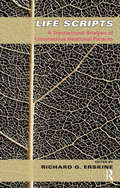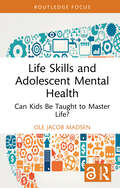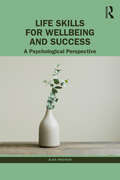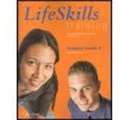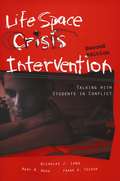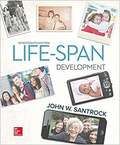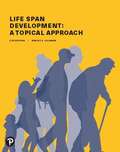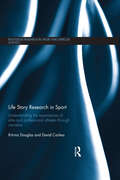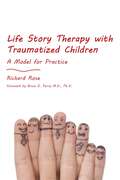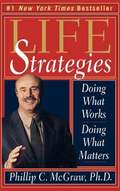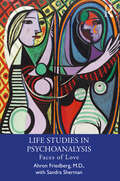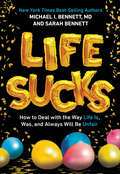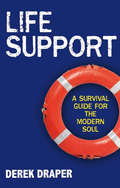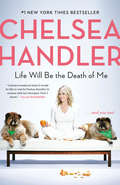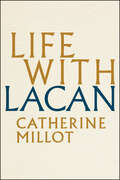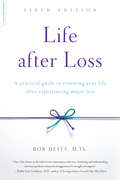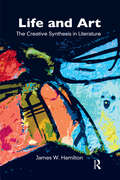- Table View
- List View
Life Review In Health and Social Care: A Practitioners Guide
by Jeff Garland Christina GarlandHow can understanding our past help us face the future? The key to gaining awareness of the present and preparing for the future lies in our understanding of the past, yet there is little coverage of this topic in the existing psychology and counselling literature. How can people improve themselves by greater self-knowledge? Jeff and Christina Garland break new ground in making a straightforward presentation of the theory and practice of the everyday process of life review, which is atherapeutic approach for helping clients make sense of their past, and can be used to help change undesirable behaviour and plan for the future. The theory and structure of the life review process are examined, and clinical examples of how it works in practice are given; this includes interviews both with "narrators" (people engaged in life review) and "listeners" (health and social care professionals). These examples demonstrate how professionals can use life review to help their clients overcome difficulties in their lives and face the future with confidence. Life Review will appeal to trainees and practitioners in occupational, developmental, clinical and health psychology, social work, counselling, psychotherapy and nursing.
Life Scripts: A Transactional Analysis of Unconscious Relational Patterns
by Richard G. ErskineLife Scripts: A Transactional Analysis of Unconscious Relational Patterns is an exciting collection of contemporary writings on Life Script theory and psychotherapeutic methods. Each chapter describes an evolution of Eric Berne's original theory and brings together a stimulating range of international perspectives, theoretical positions, clinical experiences and psychotherapy practices, as well as a psychotherapy story that illustrates the theory. The concept of Life Scripts has frequently been associated with the determinism represented in theoretical scripts, yet, this book offers some new and diverse perspectives. A few contributors address the significance of early childhood experiences in forming a Life Script, while others reflect the perspectives of post-modernism, constructivism, existential philosophy, neuroscience, developmental research, mythology and the importance of narrative.An illustrious group of authors has integrated a broad professional perspective into their understanding of a theory of mind, theories of personality and the methods of psychotherapy. Each chapter provides a unique theoretical perspective; some are provocative and challenge Berne's and others long held notions about Life Scripts.
Life Skills Education for Youth: Critical Perspectives (Young People and Learning Processes in School and Everyday Life #5)
by Joan DeJaeghere Erin Murphy-GrahamThis open access volume critically reviews a diverse body of scholarship and practice that informs the conceptualization, curriculum, teaching and measurement of life skills in education settings around the world. It discusses life skills as they are implemented in schools and non-formal education, providing both qualitative and quantitative evidence of when, with whom, and how life skills do or do not impact young women’s and men’s lives in various contexts. Specifically, it examines the nature and importance of life skills, and how they are taught. It looks at the synergies and differences between life skills educational programmes and the way in which they promote social and emotional learning, vocational/employment education, and health and sexuality education. Finally, it explores how life skills may be better incorporated into education and how such education can address structures and relations of power to help youth achieve desired future outcomes, and goals set out in the Sustainable Development Goals (SDGs). Life skills education has gained considerable attention by education policymakers, researchers and educators as being the sine qua non for later achievements in life. It is nearly ubiquitous in global and national education policies, including the SDGs, because life skills are regarded as essential for a diverse set of purposes: reducing poverty, achieving gender equality, promoting economic growth, addressing climate change, fostering peace and global citizenship, and creating sustainable and healthy communities. Yet, to achieve these broad goals, questions persist as to which life skills are important, who needs to learn them, how they can be taught, and how they are best measured. This book addresses these questions.
Life Skills and Adolescent Mental Health: Can Kids Be Taught to Master Life? (Routledge Focus on Mental Health)
by Ole Jacob MadsenCan school teach us to master life? This book confronts what the author sees as an ongoing trend in many Western democracies where citizens are increasingly being held accountable for their health and happiness. The author believes that the introduction of life skills in school shows a tendency to place more responsibility on the individual rather than address fundamental societal flaws that really should be solved politically. It examines how such responsibility to psychologically deal with these problems affects our mental health and quality of life. This book questions the fundamentals of the life mastery curriculum where we might be risking the creation of just another arena where children have to perform, challenging readers to evaluate more closely the premises, consequences and limitations of life mastery. The book, one of the first to question ‘life mastery’ as an achievable goal with critical reviews of the 21st century skills movement, will be of interest to psychologists, school counsellors, teachers, students, politicians, and any reader evaluating school curriculums in relation to the decline in youth and adolescent mental health.
Life Skills for Wellbeing and Success: A Psychological Perspective
by Alka WadkarThis volume covers topics on awareness about one’s psychological health, management of emotions, mental hygiene, and wellbeing. It examines different types of thinking, reasoning, problem-solving, and strategies for building emotional intelligence. The book is a unique presentation of theories, research, and applications within important areas of psychology that will help the readers understand the aspects of self – emotional, cognitive, motivational, value orientation of self, and communication styles. This book shares insights into how to utilize our potential to fulfill our expectations from life with the help of positive psychological orientation. It will serve as an invaluable guide for readers interested to work on their emotional intelligence, mental health, and personal and group wellbeing, for gaining insight into developing cognitive, emotional, social, and behavioral aspects of self. It will also be of interest to students, scholars, and researchers in behavioral sciences, mental health, cognitive psychology, social psychology, counselling, philosophy, and wellness.
Life Skills: Training Promoting Health and Personal Development
by Gilbert J. BotvinThe material in this Student Guide is for the third year of a program designed to help live a happy, healthy and productive life. We live in a complex and challenging world. To succeed in this world and effectively deal with the many problems facing us requires a specific set of skills. The program was developed by Dr. Gilbert J. Botvin, a psychologist at Cornell University, to provide an organized way for all middle and junior high school students to learn these important skills. Dr. Botvin discovered that students who received the LifeSkills Training program not only were better prepared to deal with the challenges of life, but were less likely to smoke, drink, or use drugs. This is an exciting new breakthrough which not only prevents tobacco, alcohol, and drug abuse, but teaches the knowledge and skills necessary to Increase self-esteem, ability to make decisions and solve problems, Communicate effectively, Avoid misunderstandings, Manage anxiety, Make new friends, Stand up for your rights, Say "no" to unfair requests, Resist advertising pressures, Resist pressure to use drugs.
Life Space Crisis Intervention: Talking with Students in Conflict
by Nicholas J. Long Mary M. Wood Frank A. FecserProvides teachers, counselors, and others who work in some capacity with youth with guidance in Life Space Crisis Intervention (LSCI), a crisis intervention strategy developed from Fritz Redl's 1959 concept of Life Space Interviewing, a form of mediation that turns a student's potentially destructive experience into a instructional and insightful experience.
Life Span Development
by John SantrockJohn Santrock connects current research with real-world application, helping students see how developmental psychology plays a role in their own lives and future careers. Through an integrated learning goals system, this comprehensive and chronological approach to lifespan development helps students gain the insight they need to study smarter, stay focused, and improve performance.
Life Span Development: A Topical Approach
by Robert FeldmanLife Span Development: A Topical Approach 4TH EDITION
Life Span Motor Development (5th edition)
by Kathleen Haywood Nancy GetchellAfter introducing Newell's constraints model, Haywood (University of Missouri) and Getchell (University of Delaware) examine physical growth and aging of the body as a whole and of specific body system, describe changing motor patterns over the life span, and explore the role of perception, social constraints, and exercise. The fifth edition moves the chapter on the basic principles of motion and stability from the website to the book. Annotation ©2009 Book News, Inc. , Portland, OR (booknews. com)
Life Story Research in Sport: Understanding the Experiences of Elite and Professional Athletes through Narrative (Routledge Research in Sport and Exercise Science)
by Kitrina Douglas David CarlessWhat is life really like for the elite athlete? How does the experience of being a professional sports person differ from the popular perceptions of fans, journalists or academics? Why might elite sports people experience mental health difficulties away from the public gaze? In the first book-length study of its kind, Kitrina Douglas and David Carless present the life stories of real elite athletes alongside careful analysis and interpretation of those stories in order to better understand the experience of living in sport. Drawing on psychology, sociology, counselling, psychotherapy and narrative theory, and on narrative research in sports as diverse as golf, track and field athletics, judo and hockey, they explore the ways in which the culture of sport interacts with the mental health, development, identity and life trajectories of elite and professional sports people in highly pressurised and sometimes unhealthy environments. By casting light on a previously under-researched aspect of sport, the book makes a call for strategies to be put in place to minimise difficulties or distress for athletes, for support to be tailored across the different life phases, and highlights the potential benefits in terms of athlete well-being and improved performance. The book also considers how these important issues relate to broader cultural and social factors, and therefore represents important reading for any student or professional with an interest in sport psychology, coaching, sport sociology, youth sport, counselling, or exercise and mental health.
Life Story Therapy with Traumatized Children: A Model for Practice
by Richard RoseLife Story Therapy is an approach designed to enable children to explore, question and understand the past events of their lives. It aims to secure their future through strengthening attachment with their carers and providing the opportunity to develop a healthy sense of self and a feeling of wellbeing. This comprehensive overview lays out the theory underlying life story therapy, including an accessible explanation of contemporary research in neurobiology and trauma. Featuring tried and tested ideas, with tools and templates illustrated through instructive case studies, the author identifies how life story therapy can be implemented in practice. Finally, the relationships between life story therapy and traditional 'talking' therapies are explored. Life Story Therapy with Traumatized Children is essential reading for those working with children and adolescents, including social workers, teachers, child psychotherapists, residential care staff, long-term carers, psychologists and other professionals.
Life Strategies: Doing What Works, Doing What Matters
by Phillip C. McgrawWhether its a bad relationship, a dead-end career, or a harmful habit, Dr. McGraw's 10 Life Laws will empower you to take responsibility for your own actions and break free from self-destructive patterns.<P> Drawing upon more than fifteen years of experience, Dr. McGraw explores each of the 10 Life Laws necessary to succeed, including:<P> * People do what works<P> * Life rewards action<P> * Life is managed, not cured<P> * There is freedom in forgiveness<P> Filled with case studies, checklists, and strategies that will work for you, Life Strategies will provide you with the skills you need.
Life Studies in Psychoanalysis: Faces of Love
by Sandra Sherman Ahron Friedberg, M.D.Life Studies in Psychoanalysis consists of four psychoanalytic studies, each representing a patient’s course of treatment over several years. These studies demonstrate how love, in an array of forms, is refracted through the process of psychoanalysis, which unfolds over time and reveals the complexities of human desire. The cases presented here cover topics including repressed homosexuality, a taboo desire for a sibling, obsession with a fantasy, an Oedipus complex, and transferences that become an initial obstacle to treatment. As the studies proceed, each renders the nonlinear progress of treatment, as layer upon layer of a patient’s issues are brought to light and the patient slowly, often reluctantly, comes to terms with these issues. Dr. Ahron Friedberg offers professionals techniques for encouraging patients to remain in treatment when they become resistant, demoralized, or feel like they have hit a wall. Ultimately, this book demonstrates how some patients, troubled by romantic, sexualized, fantasized, illicit, and/or uncontrollable desire, learn through psychoanalysis to accommodate their desires to what is possible and permissible in the lives that they otherwise inhabit. In this sense, the studies involve journeys from a place characterized by the epiphenomena of troubled love – grief, guilt, frustration – to one in which, through enhanced self-awareness, patients understand the sources and implications of their motivations. They come to understand why love has seemed like a minefield, and begin to find a more fulfilling path through it. Life Studies in Psychoanalysis will be of great interest to psychoanalysts in practice and in training, psychoanalytic psychotherapists, and readers looking for insight into the analytic process.
Life Sucks: How to Deal with the Way Life Is, Was, and Always Will Be Unfair
by Michael Bennett Sarah BennettFrom New York Times best-selling authors Michael I. Bennett, MD and Sarah Bennett--a book for teens that shows readers that we all deal with crap in our lives and how to laugh at some of the things we can't control.Being a teenager can suck. Your friends can become enemies, and your enemies can become friends. Your family can drive you crazy. School and teachers can be a drag. Your body is constantly changing. And everyone seems to tell you to "just be you." But just who is that? With their open and honest approach, father-daughter team Michael I. Bennett and Sarah Bennett's book is sure to appeal to teenagers and show them they aren't alone in dealing with fake friends, with parents who think they're "hip," and even how high school isn't everyone's glory days. Young readers--and their parents--are sure to find this no-nonsense, real-life advice helpful, and it will help them realize that it's okay to talk to their parents and other advisors around them about big issues that might be uncomfortable to discuss.
Life Support
by Derek DraperPsychotherapy helps thousands of people every day: they feel happier, achieve more success and enjoy better relationships. But not everyone can be – or wants to be – in therapy. Prominent psychotherapist Derek Draper has chosen to share his tips and tools from the therapy room to help exactly those people. In this groundbreaking book he explores 40 key issues that impact almost everyone's lives, uses examples drawn from real life to help you gain a better understanding of why things happen, and provides clear insights and advice that will help you think about life's new challenges in new, more positive ways. These stories will help you be a better wife, husband, parent and friend. Above all they will help you become a better you – because the more we understand why we do what we do, the more we can change ourselves for the better and enjoy the fuller, happier lives we deserve.
Life Takes Place: Phenomenology, Lifeworlds, and Place Making
by David SeamonLife Takes Place argues that, even in our mobile, hypermodern world, human life is impossible without place. Seamon asks the question: why does life take place? He draws on examples of specific places and place experiences to understand place more broadly. Advocating for a holistic way of understanding that he calls "synergistic relationality," Seamon defines places as spatial fields that gather, activate, sustain, identify, and interconnect things, human beings, experiences, meanings, and events. Throughout his phenomenological explication, Seamon recognizes that places are multivalent in their constitution and sophisticated in their dynamics. Drawing on British philosopher J. G. Bennett’s method of progressive approximation, he considers place and place experience in terms of their holistic, dialectical, and processual dimensions. Recognizing that places always change over time, Seamon examines their processual dimension by identifying six generative processes that he labels interaction, identity, release, realization, intensification, and creation. Drawing on practical examples from architecture, planning, and urban design, he argues that an understanding of these six place processes might contribute to a more rigorous place making that produces robust places and propels vibrant environmental experiences. This book is a significant contribution to the growing research literature in "place and place making studies."
Life Unscripted: Using Improv Principles to Get Unstuck, Boost Confidence, and Transform Your Life
by Dan O'Connor Jeff KatzmanLearn to collaborate with others, think on your feet, and celebrate mistakes using the skills of improv theater So many of us go through life following scripts we didn’t write for ourselves—scripts designed by our family, shaped by our friends, and influenced by the expectations of the people we meet. Using practical self-help skills rooted in improv principles and depth psychology, we can live more authentic, fulfilled, and empowered lives.
Life Values and Adolescent Mental Health (Research Monographs in Adolescence Series)
by Jacob Cohen Patricia CohenArising from the Cohens' work on the epidemiology of childhood psychopathology, this book explores the two aspects of motivational structure--ideas and values--that underlie the development of maladaptive functioning and symptoms. The first aspect is a measure of what children admire in their peers; this measure is seen as an operationalization of personal ideals. The second is a measure of life goals, seen as a representation of the contemporary structure of long-term personal values. Despite the considerable amount of attention given in the popular press and among social critics and politicians, values have been relatively neglected as a topic of empirical research in this country. To fill the void, this work uses data from a large cohort of young people who have been studied longitudinally since early childhood to elucidate three aspects of life goals and values: * What are the demographic, family, peer, school, and intrapersonal influences that shape values and life goals of adolescents? * How do they change over the course of adolescence? * What impact do these values have on the lives of adolescents and young adults? Decisions about what we find most admirable and which of the many apparently good things in life we will take on as our top priorities are consequential both for the contemporary and for the future emotional and behavioral well-being of the individual. Thus, this book explores systematically the environmental origins of ideals and values, using deprivation and attainment hypotheses to examine a variety of influences on the development of differences in values. This book also examines the relationship between the measures of children's values and psychopathology, examining both the "Axis 1" diagnosis, including disruptive behavior disorders, depression, and anxiety, and the "Axis 2" personality disorders. Providing an extensive study of the life values of adolescents and the state of their mental health, this monograph will be of interest to developmental psychologists specializing in adolescence, child clinical psychologists, and psychiatrists.
Life Will Be the Death of Me: . . . and you too!
by Chelsea HandlerIn a haze of vape smoke on a rare windy night in L.A. in the fall of 2016, Chelsea Handler daydreams about what life will be like with a woman in the White House. And then Donald Trump happens. <P><P> In a torpor of despair, she decides that she’s had enough of the privileged bubble she’s lived in—a bubble within a bubble—and that it’s time to make some changes, both in her personal life and in the world at large. <P><P>At home, she embarks on a year of self-sufficiency—learning how to work the remote, how to pick up dog shit, where to find the toaster. <P><P>She meets her match in an earnest, brainy psychiatrist and enters into therapy, prepared to do the heavy lifting required to look within and make sense of a childhood marked by love and loss and to figure out why people are afraid of her. <P><P>She becomes politically active—finding her voice as an advocate for change, having difficult conversations, and energizing her base. In the process, she develops a healthy fixation on Special Counsel Robert Mueller and, through unflinching self-reflection and psychological excavation, unearths some glittering truths that light up the road ahead. <P><P>Thrillingly honest, insightful, and deeply, darkly funny, Chelsea Handler’s memoir keeps readers laughing, even as it inspires us to look within and ask ourselves what really matters in our own lives. <P><b>A New York Times Bestseller</b>
Life With Lacan
by Catherine Millot‘There was a time when I felt that I had grasped Lacan’s essential being from within – that I had gained, as it were, an apperception of his relation to the world, a mysterious access to that intimate place from which sprang his relation to people and things, and even to himself. It was as if I had slipped within him.’ In this short book, Catherine Millot offers a richly evocative reflection on her life as analysand and lover of the greatest psychoanalyst since Freud. Dwelling on their time together in Paris and in Lacan’s country house in Guitrancourt, as well as describing their many travels, Millot provides unparalleled insights into Lacan’s character as well as his encounters with other major European thinkers of the time. She also sheds new light on key themes, including Lacan’s obsession with the Borromean knot and gradual descent into silence, all enlivened by her unique perspective. This beautifully written memoir, awarded the André Gide Prize for Literature, will be of interest to anyone wishing to understand the life and character of a thinker who continues to exert a wide influence in psychoanalysis and across the humanities and social sciences.
Life Writing and Politics of Memory in Eastern Europe
by Simona MitroiuThis volume addresses the issues of remembering and performing the past in Eastern European ex-communist states in the context of multiplication of the voices of the past. The book analyzes the various ways in which memory and remembrance operate; it does so by using different methods of recollecting the past, from oral history to cultural and historical institutions, and by drawing on various political and cultural theories and concepts. Through well-documented case studies the volume showcases the plurality of approaches available for analyzing the relationship between memory and narrative from an interdisciplinary and international perspective.
Life after Loss: A Practical Guide to Renewing Your Life after Experiencing Major Loss
by Bob DeitsThe grief and recovery classic fully revised and updated Loss is overwhelming. After a loved one's death, a divorce, an injury or disease, or another major life change, recovery often seems daunting, if not impossible. Life after Loss is the go-to resource for anyone who has suffered a major loss. With great compassion and insight, Bob Deits provides essential wisdom and practical exercises for navigating the uncertain terrain of grief and recovery. Now in its sixth edition, this guide is fully updated with new advice on catastrophic losses, guidance on using technology to foster connections and maintain support networks, and reflections from Deits' ongoing counseling and his firsthand experiences. After a destabilizing change, Life after Loss helps you to find positive ways to put together a life that is necessarily different--but equally meaningful.
Life and Art: The Creative Synthesis in Literature
by James W. HamiltonIn this volume an inquiry into the nature of the creative process is attempted by paying close attention to the lives of various artists, poets, novelists and playwrights, and selected works of each in order to demonstrate an essential relationship between the two, and that it is most difficult to delineate the nuances of the creative act by treating them as separate entitites. Emphasis is placed upon the effect of early trauma, such as object loss and various forms of deprivation, as a powerful unconscious motivating factor and upon the dream and transitional object as facilitators of the creative effort.
Life and Death: Our Relationship with Ageing, Dementia, and Other Fates of Time (The Library of Couple and Family Psychoanalysis)
by Andrew BalfourLife and Death considers ageing and mortality from a psychoanalytic perspective and from the point of view of the individual, the couple, and the family.Andrew Balfour’s approach focuses on understanding the challenges of late life and what might help us to continue to live our lives, and inhabit our relationships, as creatively as possible. The book grounds a psychoanalytic approach to understanding later life as a key point of developmental challenge for us all, through closely written accounts of the experiences of older people, as well as wider social-contextual issues. It locates itself at the interface of internal and external realities, exploring the lived experience of some of the most difficult things we can face in old age, such as dementia and other age-related illnesses and losses.Life and Death will be of interest to psychoanalysts, psychotherapists, counsellors, and psychologists in practice and in training. It will also appeal to the general reader interested in ageing and the challenges of late life.

